Metal Detector Accessories
When you first decide to try your luck detecting in the water, you will need other accessories. You need a water scoop of some sort, and a pouch to put the junk in, and something for the valuable stuff that you find.
Here is a list and photos of some of the accessories we have used and continue to use while water detecting.
The Water Detecting Scoop
 There are many different kinds of water detecting scoops, but this Sunspot
Scoop is the only one we use. The heavy duty construction has turned out to be the best for us for water hunting. We did have a problem with one of them, but (Chuck) the Scoopman quickly sent a replacement.
There are many different kinds of water detecting scoops, but this Sunspot
Scoop is the only one we use. The heavy duty construction has turned out to be the best for us for water hunting. We did have a problem with one of them, but (Chuck) the Scoopman quickly sent a replacement.
The only downside for the Sunspot water scoops, is that real small items fall through the holes, (even though there are smaller holes at the tip.) We've actually dug small gold post earrings and other things, just to see them quickly disappear again.
Once we tied a magnet to the bottom of the inside, to try to catch the small metal items, but after 15 minutes of scooping, the magnet would be full of black (iron) sand. The magnet wasn't attracting the gold or silver anyway, so we took it out.
 The wooden handle on this water scoop floats upright which is very convenient when you're in water that is waist deep, to find it easily.
The wooden handle on this water scoop floats upright which is very convenient when you're in water that is waist deep, to find it easily.
One thing we found out is that these scoops are difficult to use in the surf. Our procedure in the surf would be to dig after a passing wave, and pull the scoop out of the water before another wave washes away all that you just dug. Plus, the scoop needs to be facing in the right direction when you pull it out, it should be towards the sea.
All in all, these water scoops work great for us, and we are happy with them. You can use it in dry sand to practice before you get in the water. It seems that Chuck has made several models recently to improve it, and has a hand scoop too. Reilly's Treasured Gold has several available models too.
Make a Floating Sifting Screen
 They say that necessity is the mother of invention. A water screen has got to be the most time saving water hunting item you can construct. We got tired of the tiny items falling through our water scoop so we made something to catch them.
They say that necessity is the mother of invention. A water screen has got to be the most time saving water hunting item you can construct. We got tired of the tiny items falling through our water scoop so we made something to catch them.
I started out using an inner tube and a goldpanning screen, but it wasn't stable enough. It kept tipping over from the weight of the sand.
Then I constructed a rectangle screen out of PVC piping and wire mesh, but found it also tipped easily from the weight of the gravel that you dump into it. This photo of us shows the PVC screen.
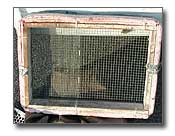 We are now using the screens in this lower photo, they are constructed out of 1 X 4 and then I taped some construction foam around them to make them float, and tied them together with plastic wire ties. Notice that I have a smaller size screen overlapping the larger size hole screen to catch 22 caliber shells and small nails. They have worked out really good, and have lasted a long time.
We are now using the screens in this lower photo, they are constructed out of 1 X 4 and then I taped some construction foam around them to make them float, and tied them together with plastic wire ties. Notice that I have a smaller size screen overlapping the larger size hole screen to catch 22 caliber shells and small nails. They have worked out really good, and have lasted a long time.
You can attach a rope to it on the side and tie it on you somewhere, and then just let it float around out of your way, till you're ready to dump something into it. Unfortunately, these screens do not work well in choppy surf.
Treasure Hunting Pouches
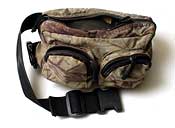 I guess we need to say something here about what we've been using to put our trash and treasures in while water hunting. We kind of have decided that fanny packs are our favorite choice because they zip up.
I guess we need to say something here about what we've been using to put our trash and treasures in while water hunting. We kind of have decided that fanny packs are our favorite choice because they zip up.
Several times we've been fortunate enough to find some camouflage hunting pouches in the Sports Dept. at Walmart which do well in the water also.
We try to get the ones with plastic zippers because the salt water eats the metal ones up real fast. Carol uses the large one for junk, a small one for coins and the other one for jewelry. Always make sure they are zipped, even the one with the junk.
Waterproof Containers
 Also in the water, some water hunters use a net bag that scuba divers use, and tie it to their waist on a belt. You can use the small mesh laundry bags too. The items stay in, and the small rocks, sand and water fall through.
Also in the water, some water hunters use a net bag that scuba divers use, and tie it to their waist on a belt. You can use the small mesh laundry bags too. The items stay in, and the small rocks, sand and water fall through.
For the valuable items you find use a small plastic waterproof container that hangs around your neck on a string and tuck it inside your wetsuit.
These were highly recommended by a friend who had lost rings when his fanny pack accidentally unzipped. You can find these waterproof containers at Dive Shops.
Waterproof Waders
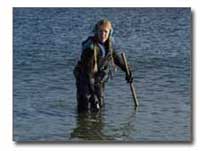 If your only going to be detecting knee to thigh deep, try investing in some waders. The best ones we have found and prefer, are made of a nice durable neoprene material, which gives you added flexibility in the water. They are at Walmart for about $70.00.
If your only going to be detecting knee to thigh deep, try investing in some waders. The best ones we have found and prefer, are made of a nice durable neoprene material, which gives you added flexibility in the water. They are at Walmart for about $70.00.
The first waders we bought were cheaper, made of a rubber material. It didn't take long for us to get holes in them. The picture is of Carol in a pair of these rubber waders. You can see how bulky and uncomfortable they look.
One problem with waders is that they don't carry sizes for women, so Carol has to put a boot insert or padding in them. She doesn't mind because her feet stay warmer. When you are detecting in the water you have to be careful and watch the incoming waves and tide, otherwise you will get swamped. So don't forget to stay shallow.
Wetsuits
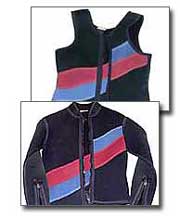 Wetsuits are more affordable nowadays then ever before. You can get a brand new pair for under a hundred bucks at any dive shop. They even carry a used line starting at $25.00 too.
Wetsuits are more affordable nowadays then ever before. You can get a brand new pair for under a hundred bucks at any dive shop. They even carry a used line starting at $25.00 too.
The main thing to remember is to try it on! Most times we have to go with the larger or extra large sizes. They can come in one piece or two pieces. The set in the photos we purchased on Ebay for $40.00, and they are too small. Vlad's favorite pair right now is made by US Diver.
Wearing a wetsuit keeps you warm in the water and allows you to go deeper than waders do, which is important especially at low tide. During the summer take the outer top off and enjoy some sun. Wearing waders and carrying all your equipment to the shore, gives people the impression you know what your doing even if you don't.
Gloves
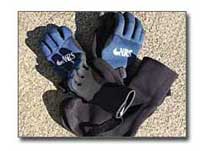 Water hunting gloves come in real handy. We started out by using winter gloves that Walmart sells. They are neoprene with a rubber palm. They are about $10.00 a pair and they are sold in the Sporting Goods Dept. These appear to be seasonal items though, so we had to watch for them to come in, just to have some. But we were wearing them out too fast. Especially the right hand glove and thumbs, because of the sand friction and digging with the water scoop.
Water hunting gloves come in real handy. We started out by using winter gloves that Walmart sells. They are neoprene with a rubber palm. They are about $10.00 a pair and they are sold in the Sporting Goods Dept. These appear to be seasonal items though, so we had to watch for them to come in, just to have some. But we were wearing them out too fast. Especially the right hand glove and thumbs, because of the sand friction and digging with the water scoop.
The gloves you see in the photo are made by NRS supplies, we found them online and decided to spend some extra bucks and give them a try. They are made for canoeists, and as you can see they are specially designed with curved fingers. They have lasted us for two seasons now.
Underneath the gloves are some neoprene booties we wear with our water boots.
Water Dive Boots
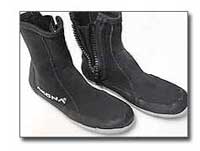 Dive boots are a necessity with your wetsuit! You can get them at the Dive Shop too. They cost around $40.00, but they are well worth it. Get some water boots that are flexible yet durable. Some have a zipper up the side some have no zippers.
Dive boots are a necessity with your wetsuit! You can get them at the Dive Shop too. They cost around $40.00, but they are well worth it. Get some water boots that are flexible yet durable. Some have a zipper up the side some have no zippers.
The zippers do have tendency to get sand in them though, when you're walking on the beach to get back to your car. So keep a gallon of water in your car to rinse them off, and to rinse the rest of your equipment. You'll want to wear your water boots all the time. Not only for the protection they give your feet, but from unforeseen objects, and they are so comfortable.
Snorkel and Mask
 Snorkel and mask, you say? Well, some professional water hunters like to put their face in the water to see what they are digging. They say it helps pinpointing your target too. A mask and snorkel is optional equipment, you don't really need, but it may come in handy just to go those extra few inches deeper. Plus you may spot an earring or two laying on top. There's a trick to using the snorkel, mask and earphones all at once, see how Carol has it set up.
Snorkel and mask, you say? Well, some professional water hunters like to put their face in the water to see what they are digging. They say it helps pinpointing your target too. A mask and snorkel is optional equipment, you don't really need, but it may come in handy just to go those extra few inches deeper. Plus you may spot an earring or two laying on top. There's a trick to using the snorkel, mask and earphones all at once, see how Carol has it set up.
They make snorkels that keep the water from going in the end if you go to deep, so pay the few extra bucks for a good mask and snorkel . Learn how to water hunt without it first. We highly recommend and stress most urgently, practicing using it them, so you don't drown. HH
Read the Water Hunting Tips
See the Waterproof Detectors we use.
Also check out my new
Casio Tide Watch A must have for any water hunter!